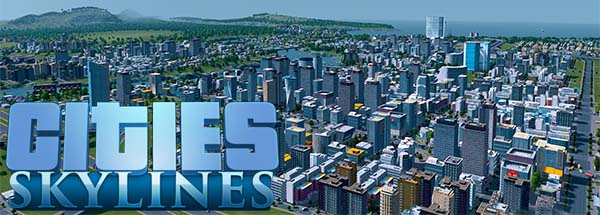
I've been playing the somewhat-underwhelming After Dark expansion for Cities: Skylines. I love Skylines, but there are a lot of elements of the game that I wish would change, and a few things that I would like to see added. I hope (and expect) that Colossal Order will continue to support the game for many years to come with new DLC and expansions, and this blog will outline some of the features, mechanics, and items that I would like to see changed or added to the game.
It should go without saying that, since this is a PC game (with a built-in asset creator), many (if not all) of the following suggestions might already be implemented in one or more mods. I haven't played much with mods in this game yet, so I don't know what might be available. In any case, there's no reason why ideas already implemented in mods can't also be turned into formal game systems by the developers.
Table of Contents
The one thing I miss from SimCity (2013): Modular buildings
As much as I love Cities: Skylines, and as much as I think it blows the SimCity reboot out of the water, there is one mechanic of SimCity that I absolutely love, and that occasionally makes me want to go back to SimCity: building upgrades. It's a bit ironic that SimCity, with its ridiculously limited city size, is the game that allows you to add additional components to existing buildings that makes them take up more physical space; yet, Skylines, with its expandable city plots, uses only prefab buildings of set sizes. So the game that puts a premium on real estate availability encourages you to leave empty space around certain buildings. I guess it makes sense. SimCity's limited size means you can't afford to build whole new buildings and must make due with what you have. Skylines allows you much more space to just keep copy-pasting the same schools and garbage dumps every few blocks.
Having to build new schools every four or five blocks can become tedious in Skylines, especially when the city starts to cross into being a metropolis. I like that the game requires that you build more infrastructure in order to keep up with population growth, but I wish that you could push the existing buildings a bit further before having to build whole new ones. This also applies to other services like clinics, fire stations, universities, garbage dumps, cemeteries, and so forth. I really liked how SimCity would allow you to add additional classrooms to your schools if the building reached capacity, rather than have to build a whole new school. I also liked the concept of customizing the functionality of some buildings. A hospital could be given an expanded trauma center, a high school can have a gymnasium added that increases the health of students, a university could have dorms added that spare the students from having to commute, and even industrial buildings could have additional infrastructure added to make them more effective. Granted most of the add-ons to buildings were superficial (like adding a sign or a billboard), but I still liked the extra bit of personalization, and it went a long way towards making major structures like airports and university campuses feel as genuinely big and sprawling as their real-world counterparts, and they would grow organically along with the city.
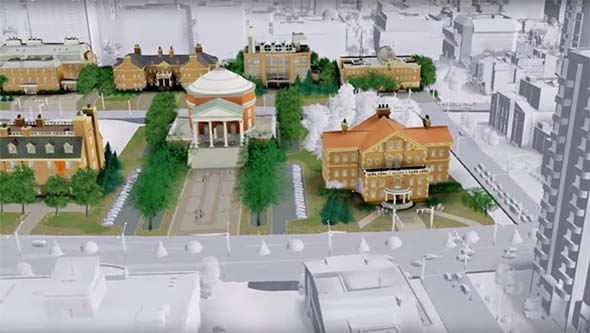
Expandable buildings in SimCity feel sprawling and grow organically along with your city.
Such buildings in Skylines often feel small and easily blend into the rest of the city-scape. I wish that Skylines had some of that customization capability. I'd like to be able to add a soccer field or a quad to my high schools. I'd like to be able to just extend my existing garbage dump instead of having to build a whole new one. I'd like to be able to add an extra incinerator to my coal power plant to increase its energy output. And I'd like to be able to add an extra ambulance garage to my hospital. I think that this would be a much more fun and engaging way to meet increasing demands from the citizens than the simple, abstract "increase funding" approach that the game currently uses. At a more superficial level, it also would add some more visual variety to the game that would make a city look more like "your city" rather than just a "Cities: Skylines city".
Suggestions for specific building upgrades
Below are some ideas for specific upgrades that could be added to certain ploppable buildings. Some of these ideas are specifically geared towards working with the new mechanics that I propose elsewhere in this wishlist post.
[Show Building Upgrade List] [Hide Building Upgrade List]
Elementary School
- Classroom wing and/or portable classrooms = increases student capacity (and available teacher jobs) at that school.
- Kindergarten / preschool / pre-K classroom = allows relevant younger children to attend the school (and available teacher jobs), increasing their total education level.
- Playground = make the playground that already appears in the school become an optional upgrade that increases student satisfaction and health a little bit.
- Field = a large grassy field on the school grounds for students to run around on during recess. It increases student satisfaction, land value, and health a little bit.
- School bus depot = increases the number of school buses available to the school (and available school bus driver jobs), and sends schoolbuses out to pick up students.
- Parking lot = large parking area for faculty that reduces the need to parallel park on the street or use other nearby public parking.
- Drop-off / pick-up lane = similar to a bus/taxi lane, but allows parents to drop off and pick up students at the school without slowing down through traffic.
High School
- Classroom wing and/or portable classrooms = increases student capacity (and available teacher jobs) at that school.
- Quad = open area in the middle of the school. Decreases student capacity at that school, but increases land value.
- Athletic field = a baseball diamond and/or soccer field and/or football field and/or track. Allows students to participate in extracurricular sports. Increases the satisfaction of students, provides health boost to students, and possibly provides leisure for students and their families who can play in or watch high school sports. Generates noise pollution.
- Athletic courts = a basketball court and/or tennis court. Allows students to participate in extracurricular sports. Increases the satisfaction of students, provides health boost to students, and possibly provides leisure for students and their families who can play in or watch high school sports. Generates noise pollution.
- Pool = a swimming pool for students. Allows students to participate in extracurricular sports. Increases the satisfaction of students, provides health boost to students, and possibly provides leisure for students and their families who can play in or watch high school sports. Generates noise pollution.
- Indoor pool = indoor swimming pool alternative. Same as outdoor pool, but more expensive and does not generate noise pollution.
- Gymnasium = an indoor gymnasium. Allows students to participate in extracurricular sports. Increases the satisfaction of students, provides health boost to students, and possibly provides leisure for students and their families who can play in or watch high school sports.
- School bus depot = increases the number of school buses available (and available bus driver jobs) to the school, and sends school buses out to pick up students.
- Parking lot = large parking area for faculty and students that reduces the need to parallel park on the street or use other nearby parking.
University
- Dormitory = allows some students to live on-campus. This reduces the need to commute and alleviates traffic congestion around the campus. Additionally, having on-campus housing could promote "out-of-state" students to attend the school, who can then get jobs in the city and increase your population.
- Fraternity / Sorority house = allows small amount of on-campus living and increases student satisfaction. Generates a lot of nighttime noise pollution.
- Classroom building = increases student capacity (and available professor jobs).
- Quad = open area in the middle of the school. Decreases student capacity at that school, but increases land value.
- Practice field = a baseball diamond and/or soccer field and/or football field and/or track. Allows students to participate in collegiate sports. Increases the satisfaction of students, provides health boost to students, and possibly provides city-wide leisure for people who want to watch college sports. Generates noise pollution. Requires that the city also have a stadium for the respective sport(s).
- Arena = an on-campus sporting arena (i.e. basketball arena). Allows students to participate in collegiate sports. Increases the satisfaction of students, provides health boost to students, and possibly provides city-wide leisure for people who want to watch college sports. Generates noise pollution.
- Parking lot / garage = large parking area for faculty and students that reduces the need to parallel park on the street or use other nearby parking.
Additionally, the university could follow the SimCity model by allowing you to specialize the school in one or more subjects (such as law, medicine, engineering, business, science, etc), which would provide a boost to relevant industries and services in the city. Other buildings in the city's economy could then optionally have requirements for workers with specialized educations. Law firms could require workers with law degrees, hospitals could require workers with nursing and medical degrees, police stations could require workers with criminal justice degrees, offices could require workers with business or economics degrees, and so on.
Clinics and Hospitals
- Patient wing = adds additional patient capacity (and available doctor/nurse jobs) to this building.
- Ambulance depot = increases the total number of ambulances available (and available driver jobs) at this building, and sends ambulances out to pick up patients.
- Morgue = stores a small amount of dead bodies. Bodies can be transferred to a cemetery or crematorium by emptying the building.
- Maternity wing = increases birth rate within the service area of the building ,and adds small amount of additional doctor and nursing jobs.
- Diagnostic Center (hospital only?) = early-detection for diseases. Increases overall health in the building's service area by preventing some citizens from getting sick to begin with, and increases amount of available doctor and nursing jobs.
Police Station and Headquarters
- Patrol car depot = increases the total number of squad cars available for police patrols.
- Jail = allows a small amount of criminals to be held in this building.
- Helicopter pad = enables a police helicopter to be used, which decreases city-wide crime rate.
- Detective's office = lowers crime rate by preventing certain crimes before they happen.
Fire House and Fire Station
- Engine garage = increases the number of fire engines available to this building.
- EMT = adds an EMT to the fire station, which serves as an extra ambulance.
Cemetery
- Crematorium = Either the existing crematorium could be converted to be an upgrade of the cemetery, or there could be a smaller crematorium upgrade that has a smaller capacity than the full crematorium building.
Coal and oil power plants
- Extra turbine(s) = adds one or more additional turbines (and accompanying smokestack). Increases energy output and number of employees at that power plant, but also increases pollution output.
- Scrubber = adds a pollution scrubber to the smokestacks, reducing pollution output of this power plant.
- Fuel storage = increases fuel (coal or oil) storage so that the building can operate longer without access to resources.
Hydro power plant
- Spillway = adds an additional spillway to increase the amount of water that can flow through the dam (thus, increasing power output). Dams should have the option to open and close spillways in order to control the flow of water. There could also be an option to include underwater spillways that allow the dam to continue producing electricity even if the water level in the reservoir behind the dam falls below the normal spill line.
- Water pump = adds a water pump to one side or the other of the dam. Provides water to the city if connected to the pipe system.
- Filter = adds a pollution filter to the water intakes or outtakes. Water from the intake side of the dam is cleaned before being deposited in the outtake side of the dam, reducing water pollution downstream from the dam.
[Hide Building Upgrade List]
Additionally, all plopable buildings could come with the ability to install solar panel upgrades on the building. This would provide power for that building only and relieve the daytime power grid from having to supply that building with power.
More utility from civil infrastructure
As far as I've seen so far, Skylines only comes with two civil government buildings: a courthouse and a tax office. Both are unlockable rewards. It would be nice to have more civil government and administration buildings to be able to create a true "downtown". Ideally, such buildings should have some utility, and currently, I don't get much sense that the government buildings do much of anything. The tax office claims that it makes it easier to collect taxes, but as far as I can tell, it doesn't actually do anything except boost the land value of the area and act as a prerequisite for one of the larger monumental mega-structures. Same goes for the courthouse. The Euro building DLC pack has some other government buildings, but they seem to be similarly functionless.
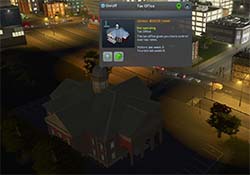
I don't think the Tax Office actually does anything.
These buildings should do something! For example, instead of unlocking tax rates by reaching a certain city size milestone, why not make the tax office enable that functionality? Similarly, the courthouse could unlock certain law enforcement policies. Both these buildings could also have passive effects. The tax office could provide a boost to tax income by reducing tax evasion or fraud as the city grows. The courthouse could passively reduce criminal recidivism, and thus reducing the overall crime rate.
Other civil administration buildings could add additional options for developing or specializing your city. Having a Department of Motor Vehicles (DMV) could unlock policies geared towards reducing the frequency of car accidents or generating additional revenue from car registration, licenses, fees, and fines. Having a post office building could facilitate an expansion of the game's economic model to allow goods to be delivered directly to people's homes via parcel delivery. And having a municipal transport agency could improve the effectiveness of buses, passenger rails, and taxi services by giving you finer control over the budget and vehicle counts of any particular route, and maybe also allow the placement of parking meters along busy streets to control traffic and generate revenue. Something like a city visitor center could also improve the effectiveness of tourism districts. A coast guard could reduce crime in coastal cities and perhaps help prevent drownings in local beaches. And I'm sure there are many more options for civil administration buildings that could have meaningful impacts on existing mechanics, or play into new mechanics that later expansions may introduce.
Seasonal specializations
The day/night cycle felt a little strange at first, and it took a while to get used to. But eventually I did get used to it, and it doesn't bother me so much anymore. I think that a good next step for this system would be in add an additional layer of seasonal changes to the game, and buildings and options to utilize the changes in season. Seasonal economies could include systems in which citizens can get part-time jobs at seasonal employers, which can create a greater continuum of social classes and employment states. Cities would now have "peak" and "off-peak" tourism seasons. A coastal city, for example, would see more tourists visiting its beaches during the summer season.
Amusement parks, national parks, and other tourist destinations could utilize "peak" seasons.
And other types of seasonal tourist destinations and maps could also be added. The obvious supplement to summer-time beach resorts would be to have some alpine, mountain maps on which ski resorts could be built that would see their peak season occur during the winter season. New tourism buildings could also include things like a National Park, Amusement Park, Water Park, Museums, and so on.
New agriculture specializations could also utilize spring (i.e. "planting") and autumn (i.e. "harvest") seasons. This could allow specialized buildings like orchards, wineries, etc. to employ citizens and generate profit based on seasonal cycles. They would be most active (and hire the most workers) during the planting and harvesting seasons, but operate with a minimized staff during their off-season. Other existing specializations like the basic agriculture and timber industries could also be affected by seasonal changes in similar ways. This could add some extra challenge to the [currently un-challenging] economic cycle by creating peaks and valleys of seasonal revenue and unemployment that could upset your city's equilibrium.
Another nuance to this system could be the inclusion of climates for each map that would affect other elements of the economy and simulation. A given map could be temperate, cold, wet, arid, and so on. Such climate conditions would determine the severity of the different seasons. Temperate maps would see minimal effects during season changes and wouldn't necessarily play differently than current cities. Arid maps would have more extreme summers that would cause increase energy consumption from air conditioning, and might not have as much water available for consumers, but which might also see an increase in the effectiveness of solar power. Cold maps would have more extreme winters, with the possibility of blizzards and snow trapping people in their homes. This could potentially also include the addition of gas utilities that would allow people to use gas (as opposed to electricity) to heat their homes.
Services like schools may be closed during the summer, leaving children free to enjoy more daytime leisure activities. There could be policies allowing you to set year-around schooling if your schools are overcrowded.
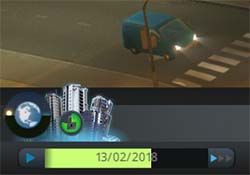
Multiple "calendar days" occur
during a single day/night cycle.
The tricky part of such a system would be to balance it with the existing calendar days, day/night cycle, and economic cycle. As it stands, a single "day" in the day/night cycle is more than a month-and-a-half of in-game calendar days. And citizens seem to operate roughly as if the day/night cycle represented a complete economic cycle. They go to work during the day, come home and go shopping or partying at night, then repeat the next morning. So the designers would have to find a way to fit a certain number of "days" into the given seasons, while fitting all the seasons into an in-game calendar year.
The simplest way to do this would probably be to make each day/night cycle cover a whole month of in-game calendar days, each season would last three day/night cycles, and there'd be four seasons in an in-game calendar year. While this would technically work, I fear that such seasons would feel exceedingly rushed. A single season would last only three day/night cycles, so your beach would only see between three and six day/night cycles-worth of activity (depending on whether tourists will also visit during the spring). Ski lodges likely wouldn't see more than just three or four days of open season. Everything would be happening so fast that it might be hard for players to get a feel for whether their city is in equilibrium, and the game might become exceedingly hard to plan and play. So a complete revision of of these systems might be required in order for a season feature to work.
Another option that would only further dissociate the calendar from the simulation would be to make each season last a full calendar-year. This way, you'd have more day/night cycles of each season, but it would take four calendar years to complete a single cycle of seasons.
Zone a coastal area as "public beach"
Public beaches have always been an awkward thing for city-builders. Both Cities: Skylines and Cities XL include buildings that you can plop along coastlines. But these are like piers and volleyball courts and things of that nature. People don't just go to the beach itself. I think the best representation of beaches was in SimCity 4. That game allowed you to create a "public park" type along the coasts that created a sandy beach on which people could be seen playing volleyball and swimming and so forth.
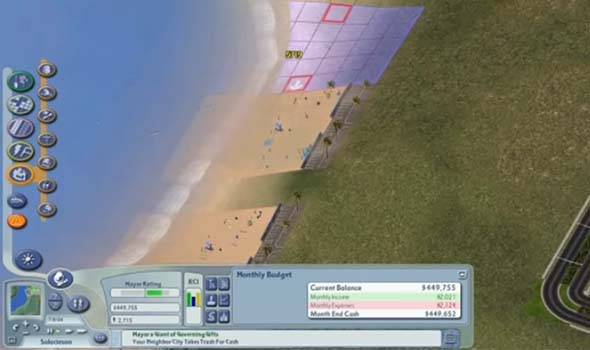
My favorite depiction of public beaches in a city builder is SimCity 4's ploppable beaches.
I'd like to see something like this appear in Skylines, but I think that it would be better as a zone rather than a ploppable park. Making it a zoned item has the advantage of allowing it to easily shape itself to conform to the contours of the coast, rather than trying to force things into blocks, or having to make a "building" that exists partly underwater. It could be zoned next to roads within 3 or 4 tiles of a coast, and extending one or two tiles out into the water. Citizens can park and visit the beach to sunbathe, swim, or surf, and it would provide leisure and tourism appeal. Buildings like volleyball courts, surf shops, pier restaurants, and so forth would then get a boost in income if placed near (or adjacent) to such zones. Such beaches would be a great stand-alone addition to the game, but they would also work well with the season feature proposed above.
Parking lots, garages, and meters
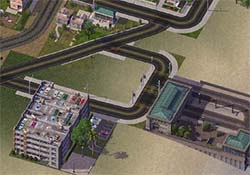
SimCity 4 had plop-able "park 'n' ride" garages.
City-building games seem to be averse to parking lots for some reason. SimCity 4: Rush Hour had parking garages that could be placed next to bus and subway stops to enable nearby residents to "park 'n' ride", but that's probably the only time that I've ever seen a city-builder include plop-able parking infrastructure of any kind. Skylines includes small parking lots for a handful of cars as part of the plots of certain buildings; although, these rarely seem to actually line up with the road, so it's unclear how drivers actually get to them. For the most part, commuters in Skylines must resort to parallel parking on the streets - heck, a lot of them don't even bother parking in their own driveways! but if there's no parking available, I think the car just temporarily vanishes into an ethereal parking lot until it is needed again.
I would like to see both parking lots and garages show up in the game, and for the game to actually enforce parking rules for commuters. Parking availability should be a game mechanic and parking meters and fines should be a method for generating city revenue. To facilitate this, the game should include the ability to plop parking lots and garages, to create parking meters, and to assign parking costs to parking in districts.
To facilitate this, parking lots and garages could be placed near industries or offices to allow commuters to park their cars for work, and near commercial zones to allow the commuter to park and visit the shops. "Park 'n' ride" mechanics could also be utilized so that commuters could park their car in a garage or lot near a bus or subway stop in a residential area, and then take the public transit to their destination. Having low parking availability could lead to dissatisfaction among the population, and possibly also lead to congestion (especially in areas that require parallel parking). Parking could also be a necessary infrastructure investment for tourist areas, and this gameplay sub-system could be another supplement to the seasons feature described above.
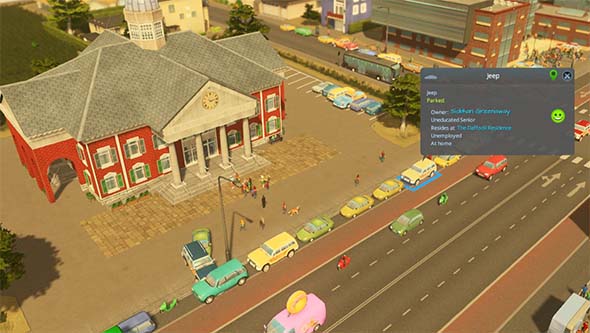
Some buildings have built-in parking, but most Skylines commuters must parallel park.
The city could also gain revenue to charging for parking. This could either be assigned per parking structure, or it could be a district-wide policy. Free parking could, of course, increase the satisfaction of commuters. Players could also be able to place parking meters along streets for additional revenue. This could possibly be handled via a district-wide policy (with parking meters showing up on park-able streets when the policy is enabled). Alternatively, roads with parking meters could be a variation of road types in the build menu, or it could be a plop-able piece of infrastructure that you place along roads similar to bus stops or taxi hubs.
I understand that simulating "looking for a parking space" might cause all kinds of havoc on the game's commuter pathfinding A.I.. This could potentially lead to logical bugs that cause unreasonable congestion or forcing drivers to circle a destination for "weeks" looking for a parking space. Obviously, if adding parking enforcement and logic to the game would cripple the commuter logic and make the game unplayable, then I don't want Colossal Order to force it upon us. But if it can be made to work, then it's definitely something that I would like to see added to the game.
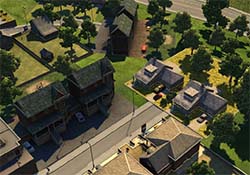
Cities XL allowed ugly, makeshift cul de sacs.
Cul de sacs
I don't think I've ever seen a city builder that has true cul de sacs. Cities XL came kind of close with the ability to place buildings at the ends of streets. This provided a more efficient use of space, but it just looked ugly. Skylines supports the ability to fairly easily create a small roundabout at the end of a road, and it's also easy to turn that into a pre-fab ploppable object, but it still doesn't work as well as I'd like. None of these methods seem perfect, and they also result in a lot of wasted space if you're trying to create enclosed housing developments (in order to reduce the number of intersections or whatnot).
I hope that Cities Skylines eventually allows the player to build cul de sacs that allow you to zone buildings around the ends of roads. Preferably, the cul de sac will be a special object that can be placed at the end of a road that would appear as a bulbous loop at the end of the road, and allows buildings to be zoned around it in a circle. Right now, the closest that you can come in Skylines would be to create a small roundabout, but it's tricky to get houses to zone properly around it, and they take up a lot of extra space.
New policy ideas
There's also still a lot of policy options that I would like to see in the game.
Rooftop Solar initiatives
As a moderate environmentalist, I would love to see the game implement some more eco-friendly policies. Having policies that enable rooftop solar on zoned buildings is a good start. In the modular upgrades section, I already proposed rooftop solar panels as an optional upgrade for ploppable buildings. Having rooftop solar policies in the city or district can be a way of extending this functionality to zoned (growable) buildings as well. Having rooftop solar should reduce the reliance on the power grid during the day (by allowing the relevant building to produce some percentage of its own power, maybe 50%), but have some upkeep cost for the city.
I suggest two separate rooftop solar options:
Commercial Rooftop Solar Requirement = requires that all new high-density commercial development install solar panels on the roof. Commercial buildings that upgrade would also have panels installed.
Residential Rooftop Solar Rebate = provides citizens with a tax rebate for installing rooftop solar. Existing houses can be retrofitted with rooftop solar, and new housing developments can be built with rooftop solar already in-place.
Historical preservation
A historical preservation policy could be enabled to preserve older buildings in the city so that they aren't torn down and destroyed. Earlier SimCity games had a similar option that could be enabled for each individual building in the game. Skylines could implement a similar function as either a district-wide policy, a district specialization, or maybe even make it toggle-able for individual buildings.
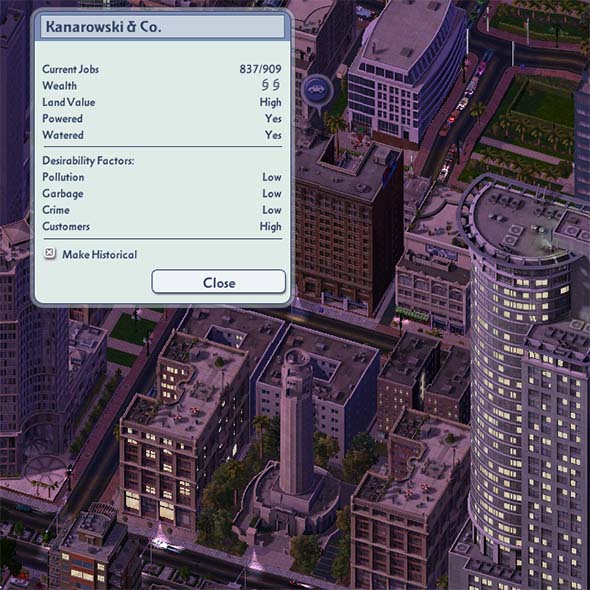
Old SimCity games allowed you to preserve old buildings as historical landmarks.
Instead of being torn down, historical buildings would continue to operate and generate some small amount of tourist appeal, but the city would pay the difference between the building's operating expenses and it's actual revenue. So if a business is historical, but doesn't make profit, the city would pay the difference in order to keep the building operating (if applicable). This would be a way to keep growable buildings that you might like, rather than possibly seeing it torn down.
Nighttime rules and policies
One of my key criticisms of After Dark was that the night cycle didn't seem to make as much of a difference as it should have. In addition to services having varying effectiveness at night, there should also be some policies oriented towards the day/night cycle.
At release, I noticed that schools seem to function at night - which I thought was weird. It seems to be a glitch, but it did give me an idea for a possible policy that the game could include: "Night School". When enabled, students can attend public schools at night (allowing them to graduate faster and/or achieve higher levels of education); otherwise, schools should operate at minimal levels at night (allowing you to lower their nighttime budget).
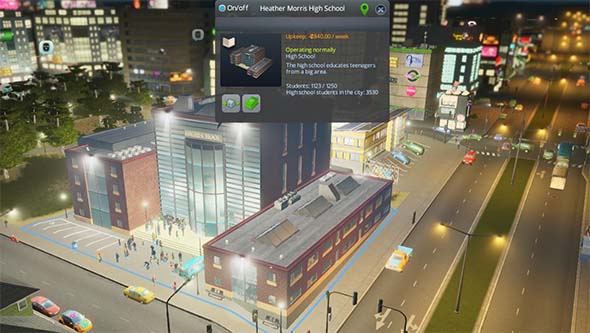
"Night School" could be a policy option to increase the education of citizens.
In the case of universities, the "Night School" policy would allow adults to attend classes after work in order to achieve higher education levels and get better jobs. This would be at the cost of not being able to do leisure activities at night, so it could result in somewhat lower happiness from such individuals.
A minor curfew that prohibits teens and children from wandering the streets at night is another potential policy candidate. It would reduce their ability to enjoy leisure activities in that district, but it would keep them out of trouble (i.e. crime).
Naming roads
You can name virtually everything in the game: districts, buildings, citizens, bus routes, individual vehicles, and so on. Pretty much the one thing that you can't name is roads. So, why not add such an ability?
Re-assign zoning blocks
Cities: Skylines has an annoying habit of automatically allocating "zoning blocks" to the sides of roads. When roads are built close to each other, or are curved, or do not intersect at 90 degree angles, these blocks can be organized into strange shapes. The player has no control over this.
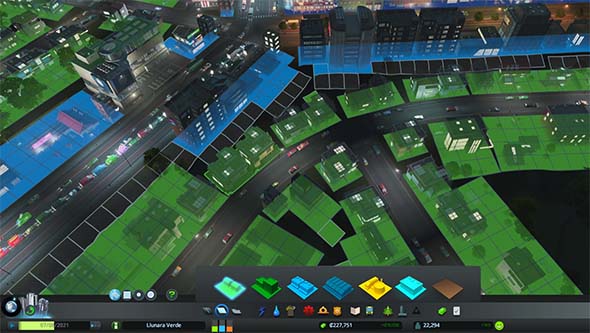
Zoning blocks are automatically placed along the side of roads and allocated between multiple nearby roads.
There are some situations in which I would like to be able to override these blocks to attach to one road rather than another. This is particularly relevant with roads that run parallel to one another within the length of one "city block". Often, if I line my roads up like this, it is because I'm trying to create a housing community that has one or two access roads going out to the main road, but is otherwise enclosed (in order to reduce the number of intersections on my main avenues). In these cases, I don't necessarily want to place buildings along the larger main road, but rather, I just want houses to run along the smaller parallel road. Because of the way the game works, those houses are going to be built on significantly smaller plots.
Having some control over the layout of these blocks would give the player more control over where their buildings are placed, and how big they are. Having some kind of interface that allows the players to add or remove blocks to zoneable land would help to alleviate issues in which oddly-shaped zones are automatically created along a curved or angled road. Perhaps we could even be allowed to place larger zones along curved roads to ensure that full-size buildings appear. It's a subtle change, but it would really help with customizing the look of my cities.
Offset the edges of roads
When upgrading a road to a larger one (i.e. upgrading from a 2-lane road to an avenue with median), you usually have to destroy the buildings adjacent in order to make room. This applies even if there are only buildings on one side. In those cases, you should be able to offset the upgrade so that it aligns with one side or the other of the original road. That way, if only one side has buildings along it, you won't have to tear them down.
Upgrading to a larger road destroys any adjacent buildings [LEFT]. You should be able to offset
the upgraded road to preserve buildings, instead of having to tear it down [RIGHT] and rebuild it.
Directional traffic congestion overlay
There are a few info overlays that aren't exactly as informative as they should be. Perhaps the most noticeable one (for me) is the traffic congestion overlay, which colors roads based on how dense the traffic along that road is. The problem is that this coloring doesn't take the direction of traffic into account; it highlights the whole segment of road with a single color. I feel that this overlay should probably use colored arrows (similar to bus routes) to show the congestion level of traffic flowing in each direction.
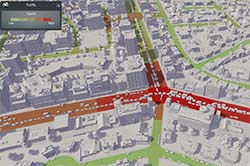
The traffic overlay should show arrows
indicating the direction of traffic.
In some cases, a single intersection may be the cause of traffic jams. In that case, only the roads leading into the intersection are problematic. Once traffic passes the intersection, traffic density is reduced. This can happen if the far end of the road is wider, if there is more distance between intersections on the far end of the road, or if traffic turns off of the congested road at the given intersection.
The problem with this proposal is handling changes in traffic flow based on time of day. A road leading into a leisure district may see high congestion during the night, but be virtually empty during the day. How should the game convey this information to the player? Should the overlay only turn red during the night? Or should it be red in that direction all the time, even though a visual inspection may not reveal the problem if you look at it during the day?
Other miscellaneous buildings
In addition to the buildings and infrastructure additions that I've requested as parts of the features above, there are other buildings that I would like to see added to the game:
Churches
Raise land value, provide happiness.
Public library
Small amount of education, increased land value, and happiness.
Private schools
Higher quality of education for a small number of wealthy children. Can only be built near high-value residences.
Low-maintenance education opportunities for poorer neighborhoods and/or people who have jobs but want to increase their education level through part-time schooling.
Athletic parks
For example: soccer courts, basketball courts, tennis courts, baseball fields, football fields, etc. Provides better health for children, increased land value, and leisure. Maybe an additional benefit if built next to schools?
Skating rink
This would work well with the Seasons expansion idea proposed above. During the summer, it could be an outdoor roller skating rink; but during winter months can turn into an ice skating rink. Would provide leisure and increase land value.
Public pool
Another athletic leisure building, but this one could have the disadvantage of possibly creating an outbreak of illness among people who use it.